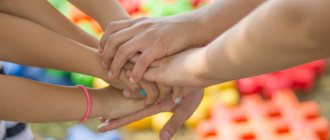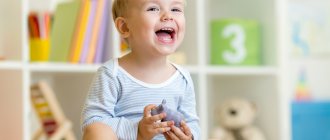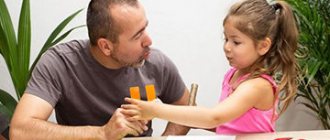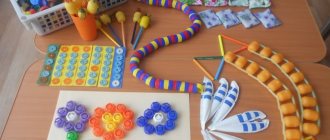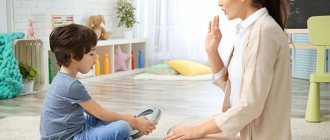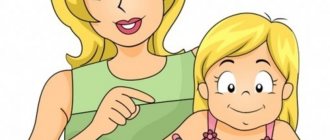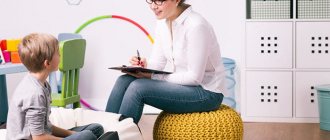During the fourth year of life, children experience one of the most significant leaps in their development. Human speech begins to be of unprecedented interest to them; they actively try to talk, repeating all the sounds that are available to them. It is at this time that parents and teachers should listen carefully, noting whether the characteristics of the child’s speech fit into the norm, and whether a 3-4 year old child requires speech therapy classes.
What should the speech of a 3-4 year old child be like?
Scientists have calculated that at this age a child’s vocabulary ranges on average from 1,500 to 2,000 words. Such calculations are difficult to make at home, but there are several simpler indicators that can easily be used to determine how well a child’s speech development falls within the normal range.
There is no cause for concern if the child:
- actively tries to reproduce all the sounds and words he hears, especially those that are new to him;
- engages in word creation;
- makes simple sentences naming actions (the ball flies, the fish swims, the dog barks);
- tries to compose complex sentences and stories, but at the same time does not speak very clearly and makes many speech errors;
- can talk about himself in the third person;
- enjoys repeating many words after adults, quoting phrases from cartoons;
- does not pronounce all sounds; problems especially often arise with [r], [l], [s] and [w];
- rearranges letters and syllables in words;
- At the same time, he himself understands complex sentences, listens carefully to fairy tales, knows his favorites by heart;
- knows and knows how to say his first and last name, the names of relatives, friends, and the city in which he lives.
The listed signs apply to both boys and girls, although experts say that girls are ahead of boys in speech development by an average of 4-5 months. There are silent children who do not speak in front of strangers, but this does not always mean a deviation from the norm: a sensitive parent usually knows what his baby is really capable of.
At this time, it is important to talk to the child as much as possible, while making sure that your own speech is correct, not to lisp, and to read books to the baby with expression.
Tests to determine pathologies
To quickly respond to changes in the baby’s development, you can conduct simple tests.
- By the fourth year, children can already distinguish the simplest geometric shapes. You need to ask the child to draw a circle. Even the similarity of this figure is a good result. However, if the child does not understand what is wanted from him, or his drawing does not even remotely resemble what is required, the test has not been passed.
- If a child does not show interest in new games and does not assemble a small tower from cubes, development is slow.
- By the age of three, the toddler communicates in short phrases (those who at this age already speak in long sentences are not taken into account). The minimum milestone for speech development by 3-4 years is the simplest phrases. If the child does not pronounce them, you should go to a specialist.
Templates of speech therapy characteristics for children of different levels for PMPC
In what cases is it still necessary to contact a speech therapist:
- The baby does not respond to his name and does not understand simple requests.
- Shows no interest in new toys; all his game scenarios follow the pattern.
- He cannot assemble a simple turret or put a large bead on a rope.
- If by the age of three the child does not speak, there were injuries during pregnancy or early development, or there are hereditary diseases.
You should regularly conduct classes with children
How to recognize disorders and when to contact a speech therapist?
The list presented above is general in nature, but if at least three points from it are not characteristic of a child’s speech behavior, this is a reason to think about it.
Here are some signs that may indicate a delay in your child's speech development:
- the pace of his speech is uneven - he sometimes speaks too quickly, sometimes he drawls out his words;
- speaks unintelligibly, only his mother understands him;
- if he speaks in phrases, then not his own, but only those he heard from adults or on TV;
- he himself has difficulty understanding what adults tell him;
- mouth constantly open, like a limp mouth;
- increased salivation not associated with teething.
If one or more signs from this list are present, it is advisable to diagnose the child’s speech development. Perhaps there really is a pathological disorder that requires special treatment, or perhaps the baby just needs speech therapy exercises. But before contacting a speech therapist, you need to show the child to a neurologist, psychiatrist and speech pathologist: they will help determine whether the delay in speech development is associated with disorders of the central nervous system or the problem is only in the pronunciation of sounds. You may also need the help of an audiologist - a specialist who identifies hearing defects. If doctors have not found any physiological reasons for the development of mental retardation, then the child will benefit from sessions with a speech therapist.
Speech characteristics of children 4-5 years old
For preschoolers, this time is a period of active vocabulary growth (by the age of 5, its volume normally reaches 3 thousand words). Children of this age begin to acquire a sense of language, handle their native speech more confidently, and engage in word creation. The grammatical structure continues to level out too.
A child of four or five years old not only begins to speak more and more freely, he also uses more and more complex sentences than before. The ability to compose a short story not only about what the child saw personally, but also without relying on his own direct experience, gradually develops. Such stories are still emotional and often have a broken logical structure, but they are quite voluminous and meaningful.
The level of phonetic perception of speech by this age also becomes significantly better. The child has the opportunity to determine the presence of a particular sound in a word and select words for a specific sound. He becomes able to perceive the syllabic rhythm of the structure of a word.
We can say that at the age of four, children begin the most active period in speech development, which allows them to acquire communicative capabilities comparable to the level of adults. Of course, it is rare that a child goes through this path without difficulties; speech disorders at this stage are most common.
Types of speech disorders in older preschoolers
There are three main types of disorders and speech underdevelopment:
- phonetic;
- phonetic-phonemic;
- general.
In practice, this means that children have difficulty recognizing, distinguishing and pronouncing the sounds of their native language. These three types of disorders can occur separately or in combination.
Normally, by this stage of development, natural age-related difficulties with the pronunciation of individual sounds or their groups should already be a thing of the past. The stage of mastering sound pronunciation is completed, children stop skipping and softening consonants in speech. At 4 years old, all hissing sounds should appear, and by 5 years old, you can expect a confident L and R sound. But in older preschoolers, articulation disorders are very common. These may be defects in the pronunciation of hissing, whistling, sonorant sounds. Almost all children have to perform speech therapy exercises on the letter and sound r; many manage to “growl” only after special training.
It is also worth paying attention to lexical and grammatical problems, which manifest themselves in the difficulties of actively using speech as a means of communication. Children with such disorders experience difficulty in composing questions and descriptions, and cannot use all the means of their native language to express thoughts. They do not know how to construct sentences correctly, use endings and prepositions incorrectly, and make mistakes when forming words. Speech therapy help in this case is necessary, but parents can also help the child speak better (of course, after consultation with a specialist).
Types and features of speech therapy classes
Speech therapy sessions can be either individual or group. On the one hand, one-on-one sessions have proven to be more effective, when all the specialist’s attention is directed to a specific child. On the other hand, children feel more comfortable in a group. Most often, a positive result is achieved by alternating these two types of activities: in group, or frontal, classes, children consolidate the skills acquired in individual ones.
Individual sessions
The most important thing for a speech therapist here is to find an approach to the child, to be able to captivate him, to “stir up” him. The baby should feel at ease, play, stick out his tongue in front of the mirror, and repeat after the specialist everything he asks. Therefore, the mood for the lesson is appropriate: it’s all just a game. To learn to pronounce difficult sounds, a child does not even need to know why he came here. For each such sound, the speech therapist has a selection of special game exercises, by performing which the little student imperceptibly improves his speech skills. Breathing exercises, songs, tongue twisters, tongue exercises - all these are effective tools in a specialist’s arsenal.
Group (frontal) classes
If individual speech therapist sessions with children are most often aimed at correcting individual sounds, then frontal sessions involve working with a wider range of deviations in speech development. These can be defects in sound pronunciation, hearing impairment, grammatical problems, and stuttering. Groups are selected small, ideally 7 people; children should be approximately the same age and have similar speech impairments. The lesson is always given some interesting topic, which provides many opportunities to expand children's vocabulary and practice oral speech. For example, in winter, the “New Year” theme is relevant: the room is decorated accordingly, creating a festive, upbeat mood in children, which contributes to the effectiveness of exercises.
As in individual lessons, here a lot depends on the personality of the specialist, on his ability to create the right environment and make children want to express themselves. For children 3-4 years old, for whom the process of socialization is just beginning, it is not easy to create such conditions. Many of them are shy and withdrawn precisely because of their speech impairments. For group speech therapy classes to bear fruit, children must feel confident and free during them.
Classes with a speech therapist. Materials and notes.
Contained in sections:
- The work of a speech therapist. Speech therapy 8475
Includes sections:
- Differentiation and automation of sounds 4125
By groups:
- Senior group
- Preparatory group
- Middle group
- Junior group
Showing publications 1-10 of 9598. All sections | Speech therapy classes
New
Photo
The best
Summary of a lesson in a senior speech therapy group on the topic “Wintering birds” Summary of a lesson in a senior speech therapy group on the topic “Wintering birds”
Goal: - activation and expansion of the vocabulary on the topic; - distinction between masculine and feminine genders of nouns. - use of the preposition na; - development of coherent speech: the ability to write a short story - description Equipment:...
Frontal GCD for literacy in the preparatory speech therapy group “Sound [X] and letter X” Goals: - improve the ability to characterize consonant sounds, practice composing complex sentences, improve skills in the formation of possessive adjectives, improve the ability to compose sentences based on a picture, consolidate definition skills...
How specialists work: exercises, games, manuals
One of the most obvious reasons for the incorrect pronunciation of sounds by young children is the imperfection of their speech apparatus. Speech therapy gymnastics helps solve this problem.
There are many fun exercises that children enjoy doing in front of the mirror, repeating after the speech therapist.
- “Window” is the simplest exercise in which the baby must first open his mouth as wide as possible (“it’s hot, open the window!”), and then close it (“it’s cold!”).
- “Brushing your teeth” - the child needs to smile and in this state open his mouth slightly, then run his tongue over the upper and lower teeth, as if with a toothbrush.
- “Cup” - open your mouth again in a smile, stick your tongue out further and give it the shape of a bowl, raising the tip and edges.
- “Fipe” - diligently stretch out your lips, as if with the intention of whistling, while clenching your teeth.
- “Painting the ceiling” - smile, open your mouth slightly and move the tip of your tongue across the sky, as if painting it with a brush.
Children like this kind of gymnastics for the tongue, but it quickly tires them. At the next stage of the lesson, you can move directly to oral speech. Various descriptive games will help with this. For example, the teacher takes out an object or toy from a bag or box and asks the child to name it. Then he asks about the properties and characteristics of the object, pushing the child to describe it (the ball is round, green, small, bouncy). If successful, you can complicate the game: ask the child to put his hand into a bag with a toy and try to tell what it feels like.
The teaching aids include pipes and turntables for breathing exercises, finger toys and exercise machines, sets with tweezers for grasping small parts, tactile bags and boards - there is a very wide choice for professional speech therapists. You can purchase such things for home use, or you can make do with improvised means.
Exercises for general speech development at home
At home, it is imperative to regularly conduct speech therapy classes for children 4-5 years old, the exercises of which include not only the speech part, but also gymnastics for the speech organs and fingers.
Finger gymnastics
This set of simple exercises stimulates the part in the brain center that is responsible for correct speech. This is why fine motor skills classes are needed not only for the little ones, but also for preschoolers.
Finger exercises stimulate the part of the brain responsible for correct speech
All exercises are done 8-10 repetitions:
- “Opening” and “closing” the fingers on each hand. First one by one, then together. You can gradually increase the speed.
- Place your hands on the table: the left one touches the table with the palm, the right one with the back. Then at the same time you need to turn your hands over.
- First, draw a river: fold your hands, palms up, as if you have water in them. Then depict a steamboat - put your palms together, press your thumbs together and lift them up. Then depict the fish that have arrived: press all your fingers together, palms together and make movements with your hands, as if a fish is swimming.
- Draw a tree with branches - arms vertically, fingers spread out in different directions. Then show the roots of the tree - in the same position, move your hands with your fingers down. Then show leaf fall: quickly, quickly clench and unclench your fingers.
Articulation gymnastics
These exercises are aimed at developing the tongue, the main organ responsible for the correct pronunciation of sounds.
Methods of speech therapy examination of children according to Akimenko V.M.
Note! Thanks to regular training in articulation gymnastics, the child will soon begin to pronounce even the most difficult sounds.
- Smile as wide as possible, teeth are closed, exactly on top of each other. Stay in this position and count 10 seconds.
- Pull your lips forward and pretend as if an elephant is drawing water with its trunk. Stay for 10 seconds in this position.
- Pretend to be a snake: smile broadly, stick out your tongue like a tube, then hide it back.
- Open your mouth wide and make a clicking sound with your tongue, imitating a horse. At the same time, it is important to ensure that the child’s lower jaw is motionless and only the tongue is working.
- Smile widely, stick out your tongue as far as possible and lightly squeeze it between your teeth. In this position, “pull” the tongue back into the mouth.
- Open your mouth wide, stick out your tongue and pretend to be a clock - move your tongue from one corner of your mouth to the other.
Repeat all these exercises 8-10 times or for 10-15 seconds.
Games for developing phonemic sound
Speech therapy games for 4-5 year old children to develop phonemic sound must be included in daily classes. They are simple and at the same time interesting, and the results will not take long to arrive. After just a month of regular exercises, the quality of children's speech will noticeably improve.
- "Game of Silence" This game is very simple. The child is asked not to make a sound for 2 minutes and close his eyes. As soon as the time is up, then ask the baby to tell what sounds he heard.
- "Clap-stomp." The essence of the game: agree in advance with the child which sound he will stomp on and which sound he will clap on. For example, if he hears the sound [w], then he stomps his foot, if the sound [r], then he claps his palms. Next, the adult names different sounds, and when the child hears the ones he needs, he claps or stomps.
- "Catch the word." The essence of this game is simple: the child is given a word, upon hearing which he will have to clap his hands. Next, the adult names several words in turn that sound similar. As soon as the child hears what he needs, he should clap his hands.
To develop phonemic sound, it is necessary to regularly play speech therapy games
How to work with your child at home?
From parents, first of all, maximum attention is required to the baby, to his interests and discoveries, fears and sorrows. We need to create conditions for him to communicate with the world, take him on walks, show him new places, introduce him to people of different ages. All this broadens the mind and develops the brain, and also strengthens the attachment between children and parents.
The quality of speech is directly influenced by the development of fine motor skills, so any activities with small objects, construction toys, sand, and cereals will be of great benefit in this regard.
You can try special exercises at home. For example, the pronunciation of hissing and whistling sounds is relatively easy to practice on your own, without the intervention of a specialist. As for the sounds [r] and [l], they are considered more difficult to correct, although you can try to “set” them too.
Every parent can reproduce speech therapy gymnastics at home - it will be much more fun and easier for the baby to repeat after his mother than after an unfamiliar aunt. It will take very little time, but will bring great benefits and give pleasant emotions to the participants. For classes, you will need a mirror - preferably a large one, so that the child can freely see both his reflection and the reflection of his mother, performing the exercises “Pipe”, “Cup” and others.
After gymnastics, you can play games with answers to questions, or you can practice pronouncing words containing problematic sounds. If you write these words on cards, it will be more convenient to study. Tongue twisters that are chosen so that the necessary sounds are often repeated in them also work well. It is important to remember that pressure should not be put on the child. Games and activities should not bring him anything but joy and pleasure, otherwise the effect may be exactly the opposite.
Homework for parents on developing general speech skills in children 3-4 years old
As part of the parent club “Speech Therapist School”, a weekly Set of homework assignments was developed to develop general speech skills , which is offered to all parents interested in the speech development of their child for the entire school year.
Tasks must be completed every week, distributed over days, 5-10 minutes a day.
November – 1 week.
1. Breathing exercise – development of long, smooth exhalation.
"Ship"
Take a plastic light boat or walnut shells, or make a paper one. Explain to the child that in order for the boat to float, you need to blow long and smoothly. While performing, read the poem:
The wind blows across the sea and propels the boat; He runs in the waves on swollen sails.
2. Development of articulatory motor skills: open and close your mouth as much as possible, stretch your lips into a smile, stretch them into a tube (you can do it in front of a mirror with a parent).
3. Development of fine motor skills: - ironing soft, plastic, rubber, embossed toys;
- do finger exercises:
The little girl Zinochka (makes her palms into a “basket”) Vegetables in the basket: Here’s a pot-bellied zucchini (bend your fingers, starting with the thumb) Placed it on the side, Pepper and carrot, Placed it deftly, Tomato and cucumber. Our Zina is great! (show thumb)
4. Development of speech understanding: remember the names of toys (doll, bear, horse, locomotive, car and others), parts of the body (head, torso, legs, arms). It is advisable to see toys or pictures.
5. Development of auditory attention: “Guess what it sounds like?”
An adult rings a tambourine, a rattle, a bell, a pipe (in front of the child) and hides behind a screen - asking the child to guess what object produced the sound.
6. Outdoor game “Dress”
The adult pronounces the text and performs the movements, and the children imitate him, pronouncing words and phrases:
This dress is for Natasha - 4 rhythmic turns left and right, hands on the belt Red peas - 4 rhythmic jumps on both legs And the dresses have two pockets - “draw” 2 pockets on the tummy Let’s hide our palms in them. – apply both palms to the tummy.
November, 2nd week.
1. Breathing exercise “Football”.
They explain to the child that with the help of cotton wool he will play football. The “soccer ball” must be blown out between two cups (shells, cubes, etc.)
2. Development of articulatory motor skills.
- “The tongue is sitting in the house, came out of the house, looked left and right, hid in the house again”;
- “smile”, “pipe-say oo-oo-oo”, open and close your mouth.
3. Development of fine motor skills.
Ladushki, ladushki (use the index finger of your right hand to make circular movements on your left palm, then change hands) Where were you? - by Grandma. Okay, okay, sonorous firecrackers. Clap-clap-clap! (claps)
On a large sofa in a row (alternately knock with fists and clap) Tanin's dolls are sitting: Two bears, Pinocchio (alternately bend fingers) And cheerful Cipollino, And a kitten and a baby elephant. 1, 2, 3, 4, 5- (alternately straighten your fingers) Help our Tanya (clap and knock alternately) We count the toys.
3. Development of auditory attention.
Listen and repeat the sounds of a tambourine, rattle, drum, metallophone or any other musical toy.
X- pause - clap, XX pause XX, XX pause X, X pause X, etc.
4. Development of speech understanding: name items of clothing for autumn, first from pictures, then without them.
5. Outdoor game “Slippers”.
These are slippers for Antoshka (they stomp on each foot 2 times) So that his feet don’t freeze in them. (4 jumps on both legs) Stomp-stomp-stomp, (stomp 2 times with each foot) What kind of slippers? Like toys! (left foot on the toe, then on the heel, vice versa).
November, 3rd week.
1. Breathing exercise “Breeze”.
Using a pinwheel, a plume, or a light object, perform a strong, short air stream:
A very hot day. Blow, blow, my little breeze. Breeze-breeze, Blow-blow, our breeze.
2. Articulation gymnastics.
- Puff up your cheeks (fat ones) - pull in your cheeks (skinny ones);
- the tongue is resting - place the relaxed tongue on the lower lip - hold.
3. Development of fine motor skills.
"Fruit Palm"
This finger is an orange (they bend their fingers one by one, starting with the big one). Of course, he is not alone. This finger is a plum, delicious, beautiful. This finger is an apricot, growing high on a branch. This finger is a pear, Asks6 “Come on, eat it!” This finger is a pineapple, a fruit for you and for us. (point with palms around and towards yourself).
4. Development of auditory attention on non-speech material.
In three identical jars - peas, buttons, semolina. Determine by ear what is in each jar.
5. Development of speech understanding.
• Development of a passive and active verbal vocabulary, consisting of names of actions (sleeping, eating, walking, jumping, playing, walking, cleaning, cleaning, washing, bathing, dressing, speaking, drawing, lucky, serving);
When looking at the pictures, the child must name the actions and can show them himself; name the actions performed by the adult.
• Distinguish between the concepts “Big and small” using toys.
6. Outdoor game “Drop”.
Drop, one (children jump on their toes, slowly at first, then speed up) Drop, two. The drops are slow at first, And then, then, then, Everyone runs, runs, runs.
November, 4th week.
1. Breathing exercise “Recognize the vegetable.”
On the table is a dish with vegetables: onions, garlic, dill, cucumber (or others).
Children examine the vegetables, name them, then rub the dill in their hands and make cuts on the vegetables. Children smell vegetables, remember smells, recognize the taste. With eyes closed, the child should recognize the vegetable by smell.
The inhalation is long and deep, the shoulders do not rise.
“Recognize the fruit” - the same thing (orange, lemon, apple).
2. Articulation gymnastics.
• “The cat is lapping up the milk.”
The cat is lapping up the milk (his wide tongue sticks out) The cat is calling us to lap (then his tongue hides in the house).
• Reinforcement: “Fat and thin”, “Tongue resting” on a count of up to 5, “Tube”, “Smile”.
3. Development of fine motor skills.
We will cook compote. (we move the index finger along the palm) You need a lot of fruits. Here. We will chop apples, (“crumb”) We will chop pears. (“they chop”) We cook, we cook compote, (“they stir with a spoon”) Let’s treat the honest people (they spread their arms to the sides).
4. Teaching the spatial arrangement of objects (fixing prepositions on, under, for).
The adult gives instructions, and the child follows them:
- put the bear on the table, under the table, behind the sofa, etc. (you can take different objects).
5. Development of auditory attention with sounding toys.
The concept of “loud-quiet”.
6. Development of speech understanding.
On the table is a ball, a cat, a bird. Learn to recognize toys by their description:
— she has a fluffy tail, soft fur, and a long mustache.
- she has wings, a beak, two legs, and her body is covered with feathers.
— it is round, red, plastic.
7. Outdoor game “Mushrooms”.
In the forest under the pine tree, mushrooms grew, (“spring”) They started a merry dance. The mushrooms nod their red caps - (tilt their heads to the right, left) They really want to please us.
December, 1 week.
1. Breathing exercise - “Whose locomotive hums louder and longer?”
Glass bottles of perfume or medicine are used. The adult stretches out his lips with a straw and blows into the bottle to make a whistle sound, then invites the child to do this (without puffing out his cheeks!).
“Whose lump will fly further?”
Using paper “snow” lumps, determine whose lump will fly away further.
2. Articulation gymnastics.
• Form and develop the correct position of the organs of the speech apparatus during sound (and), develop the vocal apparatus:
The lips smiled, the teeth showed. The lips smiled, they reached out to the ears - and-and-and-and (pull).
• Fastening: fat-skinny, the tongue is resting.
3. Development of fine motor skills “Home”.
Knock-knock-knock, knock-knock-knock! (they hit fist on fist, alternating) Take the hammer, my friend! We will build a new house, (they place their palms next to each other - “walls”) There is a window in that house, (they fold their index fingers into a shelf, the rest are connected with a “roof”) There is another one, higher, There is a pipe at the top of the roof. (little finger to the side - trumpet) The house is ready, we are inviting guests: (inviting hand gesture) “Come quickly!”
4. Development of speech understanding. Learn to understand questions (where? Where? From where? On what?) that help determine the location of an object.
For example: show and tell where the boots are, where the books are, where the TV is, where the toys are, etc.
5. Development of phonemic hearing.
Stand with your back to the adult, tell him what he is doing: knocking on a cup with a spoon, pouring water, snapping scissors, etc.
6. Distinguish between primary colors (red, yellow, blue, green) using toys, socks, mittens or other objects.
7. Outdoor game “Cow”.
“Moooo!” – the cow moos (they walk in a circle, making “horns” from their index fingers) I gore Katya and Vova. (turn their faces in a circle, make two turns left and right) Don't you drink milk? (put their hands on their belts, make an angry face) Run far away!” (run away).
8. Read A. Barto’s poems from the “Toys” series (learn by choice).
9. Read K Chukovsky “The Miracle Tree”, “Jenny”.
December, 2nd week.
1. Breathing exercise “Blowing snowflakes from a snowy clearing.”
Blow off “snowflakes”, small lumps made from cotton wool, from a sheet of paper.
Blow into store-bought reeds, tubes, pipes, or on a small turntable.
2. Articulation gymnastics.
• Exercise “Bear”.
(sound [E])
“uh-uh, like a bear, you sing, open your mouth wide. Vanya plays with Mashenka and walks around the room, as Mishutka hums: “E-uh-uh-uh.”
Exercise "Elephant"
(sound [U])
I’ll look at the baby elephant, I’ll cup my lips like a proboscis, I’ll look at the baby elephant, I’ll cup my lips like a tube: Ooo-oo-oo-oo.
• Reinforcement: “smile”, “tube”, “fat-skinny”, “tongue resting”, “open and close mouth”, “tongue goes out for a walk from the house”.
3. Development of fine motor skills.
Our Antoshka washes the dishes. (rub their palms together) Wash the fork, cup, spoon. (extend the fingers from the fist, starting with the little finger) I washed the saucer and glass, And closed the tap tighter. (perform an imitating movement).
4. Learn to distinguish between primary and additional colors.
5. Development of speech understanding.
• Teach children to quickly navigate naming actions. ask: “Where does the boy ride?” (boy rides downhill), where is the car going? (the car is driving along the road), where does the cat sleep? (the cat sleeps on the rug), etc.
• Teaches you to understand the question What?
- How does mom cut bread? (mom cuts bread with a knife) - what did you wipe your face with? (with a towel) - what do you eat soup with? (with a spoon) - what do you use to comb your hair? (comb).
6. Outdoor game “Bunny”.
Children perform movements and finish words.
Bunny in the grass hop-hop. (4 jumps in a circle, index fingers like ears) The bunny jumped behind a bush. (crouched down) The brave bunny is not afraid, (4 jumps in a circle) The fox cannot catch him. (they run away, the adult catches the children).
7. Read the fairy tale “Teremok”, “Three Bears”, S. Marshak “Cat’s House”.
December, 3rd week.
1. Breathing exercise “Breeze”.
• Place a wide tongue on your lower lip, let it rest, then, without removing your tongue from your lip, blow on something light.
2. Breathing exercise “Bubbles”.
Use a glass half filled with water and a cocktail straw. Inhale through your nose and exhale through your mouth into the tube (with a strong exhalation, water pours out of the glass, with a weak exhalation, bubbles form).
3. Development of the articulatory apparatus: form and develop the articulatory praxis of sound (ph).
Exercise "Bunny".
(the lower lip is pressed to the edges of the upper teeth, the upper lip is slightly raised)
The ears are on the top of the head, And the teeth are on the sponge (ph-f-f....) Warm air comes out (hold your palm).
4. Development of fine motor skills.
"Winter Fun"
What do we like to do in winter? (alternately connect the thumb with the others on both hands) Play snowballs, run on skis, skate on ice, race down the mountain on a sled.
"Who sleeps in winter?"
The bear in the den is fast asleep, (they clench their fingers into fists, starting with the little finger) He sniffles all winter until spring. A chipmunk sleeps in winter, (bend one finger for each animal name), a prickly hedgehog and a badger. Only the bunny can’t sleep - he’s running away from the fox. He flashes among the bushes, He chattered - and he was like that!
5. Development of speech understanding.
Arrange the pictures (or toys) in the required sequence, place them one after another as an adult says: car, cube, doll, pyramid, etc.
6. Outdoor game “It’s me.”
These are the eyes. Here. Here. (child performs imitation movements) These are ears. Here. Here. (shows body parts) This is the nose. This is the mouth. There's a backrest. There's a belly here. These are pens. Clap clap. These are the legs. Top, top Oh, tired. Let's wipe our brow.
December, 4th week.
1. Breathing exercise “Balloon”.
Blow on the balloon so that it flies to the doll, bear, or bunny.
2. Breathing exercise “Blow through a straw.”
Blow through a tube of thick paper onto a piece of cotton wool lying on the table or a feather.
3. Articulation gymnastics.
Reinforcement: “smile”, “pipe”, “fat-skinny”, “tongue resting”, pronounce the sounds (u), (e), (i), (f).
Sound [P]
Blow air into your nose, (put your palm with the cotton wool near your mouth, when pronouncing [P], the cotton wool flies away) (P) break through your teeth!
Sound [B]
[B] say it easily, turn on your little voice.
4. Development of fine motor skills.
“New Year's toys” The holiday is approaching, (alternately clapping and clenching into fists) The Christmas tree is dressing up. We hung up the toys: (alternately connect the thumb with the rest) Beads, balls, crackers. And here the lanterns hang, (alternately clapping and clenching into fists) They delight the children with their sparkle.
"Toys"
Antoshka has toys: (clench and unclench his fists) Here is a funny frog. (bend your finger for each name of the toy) Here is an iron machine. This is a ball. It's made of rubber. A multi-colored nesting doll and a cat with a fluffy tail.
5. Expansion and activation of vocabulary on the topic “New Year tree”.
Look at the tree, tell what it is like; examine the toys, specify their color;
Consolidating prepositions on and under: what's under the tree? What's on the Christmas tree?
6. Outdoor game “Christmas tree toy”.
They bought the blue ball for Lolka. (shows a circle with his hand) Oh, how beautiful! (they shake their heads, feign delight) It now hangs on the tree (they throw back their heads, look up) And it looks like a plum. (squats).
Nazarova Elena Vladimirovna, teacher-speech therapist of the joint venture “Kindergarten “Ladushki” MBOU “Secondary school No. 1”
- Speech therapist’s homework on the topic “Wild animals of our forests”
- Thematic planning of speech therapy work in the middle group (ONG)
- Thematic planning of speech therapy work in the senior group (OHG)
- Approximate thematic planning of speech therapy work in the preparatory group (ONR, FFNR)
- Thematic planning of speech therapy work in the junior group (JG)
( 5 liked, average score: 4.20 out of 5)
Loading...
